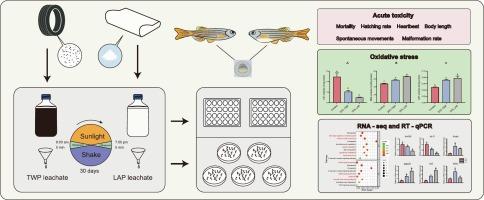Comparative toxicological impacts of tire wear and latex particle leachates on zebrafish embryos: Chemical characterization, oxidative stress, and transcriptomic disruption
IF 4.3
3区 环境科学与生态学
Q2 BIOCHEMISTRY & MOLECULAR BIOLOGY
Comparative Biochemistry and Physiology C-toxicology & Pharmacology
Pub Date : 2025-08-12
DOI:10.1016/j.cbpc.2025.110323
引用次数: 0
Abstract
Rubber-derived pollutants, such as tire wear particles (TWP) and latex particles (LAP), pose increasing threats to aquatic ecosystems due to their complex chemical composition and potential toxicity. This study systematically evaluated the embryotoxicity of 30-day leachates from TWP and LAP (10 g/L) in zebrafish (Danio rerio) by integrating chemical characterization and toxicological assessment. ICP-MS and GC–MS analyses revealed elevated levels of toxic metals, notably zinc and aluminum that exceeded established ambient water quality criteria for aquatic life, along with numerous organic contaminants including antioxidants, plasticizers, and accelerators. LAP leachates exhibited significantly greater toxicity than TWP, as indicated by a lower LC50 (3.33 g/L), increased mortality and malformation rates, delayed percent hatched, and reductions in spontaneous movement, heartbeat, and body length. Oxidative stress biomarkers revealed disrupted antioxidant enzyme activity and elevated malondialdehyde (MDA) levels, particularly in the LAP group. Transcriptomic profiling revealed that both ferroptosis and arachidonic acid metabolism were commonly enriched pathways. Notably, LAP exposure induced broader alterations in metabolic and inflammatory processes, whereas TWP exposure primarily impacted stress and apoptosis-related pathways. RT-qPCR validation confirmed significant gene expression changes, including the downregulation of cardiac-related genes (tnnt2d, stc1l) and upregulation of oxidative stress and inflammation markers (ptgs2b, mt2). Collectively, these findings demonstrate the heightened embryotoxicity of LAP leachates and the divergent molecular responses elicited by TWP and LAP, underscoring the need for targeted environmental regulation and risk mitigation strategies.

轮胎磨损和乳胶颗粒渗滤液对斑马鱼胚胎的比较毒理学影响:化学表征、氧化应激和转录组破坏
橡胶衍生污染物,如轮胎磨损颗粒(TWP)和乳胶颗粒(LAP),由于其复杂的化学成分和潜在的毒性,对水生生态系统构成越来越大的威胁。本研究采用化学表征和毒理学评价相结合的方法,系统评价了TWP和LAP (10 g/L) 30 d渗滤液对斑马鱼(Danio rerio)的胚胎毒性。ICP-MS和GC-MS分析显示,有毒金属含量升高,尤其是锌和铝,超过了水生生物的既定环境水质标准,此外还有许多有机污染物,包括抗氧化剂、增塑剂和促进剂。LAP渗滤液的毒性明显高于TWP, LC50较低(3.33 g/L),死亡率和畸形率增加,孵化率延迟,自发运动、心跳和体长减少。氧化应激生物标志物显示抗氧化酶活性被破坏,丙二醛(MDA)水平升高,尤其是在LAP组。转录组学分析显示,铁下垂和花生四烯酸代谢都是常见的富集途径。值得注意的是,LAP暴露诱导了代谢和炎症过程的广泛改变,而TWP暴露主要影响应激和细胞凋亡相关途径。RT-qPCR验证证实了显著的基因表达变化,包括心脏相关基因(tnnt2d, stc11)的下调以及氧化应激和炎症标志物(ptgs2b, mt2)的上调。总的来说,这些发现表明了LAP渗滤液的胚胎毒性增强,以及TWP和LAP引起的不同分子反应,强调了有针对性的环境监管和风险缓解策略的必要性。
本文章由计算机程序翻译,如有差异,请以英文原文为准。
求助全文
约1分钟内获得全文
求助全文
来源期刊
CiteScore
7.50
自引率
5.10%
发文量
206
审稿时长
30 days
期刊介绍:
Part C: Toxicology and Pharmacology. This journal is concerned with chemical and drug action at different levels of organization, biotransformation of xenobiotics, mechanisms of toxicity, including reactive oxygen species and carcinogenesis, endocrine disruptors, natural products chemistry, and signal transduction with a molecular approach to these fields.

 求助内容:
求助内容: 应助结果提醒方式:
应助结果提醒方式:


